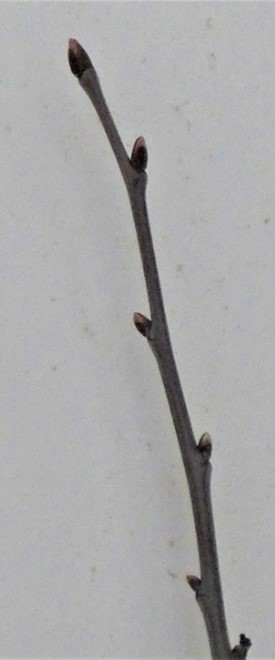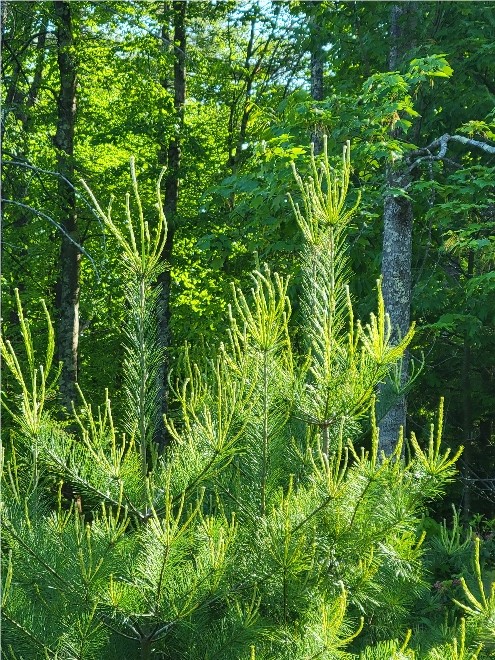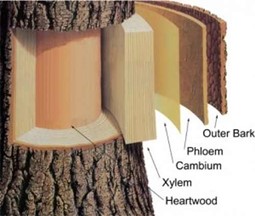The Pulse of Growth
Here we are – the annual riot of growth – many shades of green, along with the black flies and ticks to dampen the mood. Let’s look at a bit more of the detail of all that growth – what you see is just part of it.
Who Gets the Food?
While all aspects of growth are essential for long-term survival of individual trees and species, some facets are “more essential” than others in divvying up available photosynthate when it is limited. It is dangerous to oversimplify the order of priority, but this ranking is generally useful:
- Respiration to maintain living tissue
- Fine roots and leaves: to gather water and minerals, and to actually photosynthesize
- Flower and seed production: for species survival
- “Primary growth:” shoot extension (height growth and crown expansion)
- New phloem: for downward conduction of photosynthate
- “Secondary growth:” diameter growth
Leaves and Shoots
Dormancy and intermittent growth are key traits of species that have evolved to survive in this temperate climate where we live. The bud is a tiny package of giant potential. In most of the common species gracing our woods, the bud holds the elements of the upcoming year’s growth, leaves already formed in miniature.

When the photoperiod (day length) is right, buds swell, then open, leaves or needles emerge and the shoot grows. Generally, and subject to all the usual caveats, trees in our area accomplish most of their primary growth early and secondary growth later in the growing season. (Taller and wider first, fatter second.) Find some nearby white pines that are about 5 or 10 feet tall. If you observe them every few days beginning in mid-May and through July, you can get a good sense of when shoot growth is fast and when it slows (Fig. 2).

Roots
While leaf expansion and shoot growth are the highly visible parts of annual growth, there’s a lot more going on. Before buds even begin to expand visibly, the root system has likely been active. Root systems are hard to observe, measure and monitor – for obvious reasons. They are also variable in structure across species, and often influenced by soil characteristics and site quality. Trees on poor sites need to devote more of their resources to the root system to provide the water and minerals needed for photosynthesis. There is ample evidence that production of new fine roots typically begins before the aboveground growth spectacle begins, and almost certainly continues after the cessation of aboveground growth in the fall. Some seminal root system research took place at the Harvard Forest in Petersham. UMASS’ own Bill Wilson was one of the principal researchers, and his fascinating book The Growing Tree (Univ. of Massachusetts Press, 1970) includes the results from some of this research. If you want to dive into the nitty-gritty of how trees grow, this book is technical, but highly readable.
Cambium, Xylem and Phloem
The cambium, a thin layer of cells just inside the bark, produces phloem on its bark side and xylem on its inside (Fig. 3). Xylem is the wood that increases a tree’s diameter. Everyone is familiar with annual growth rings distinguishable in the wood of most native trees. The rings are generally visible because the cells forming earlier in the growing season are larger than those formed later. Also, cell wall thickness typically increases later in the growing season.

As already noted, the addition of wood to a tree’s stem is a relatively low priority in the survival hierarchy. But diameter growth can continue late into the year. It can also stop and start, as conditions dictate. It would be reasonable to assume that the width of a growth ring for a particular year would be the same at all locations along the tree stem. Not so, especially in times of stress and low photosynthate availability. The growth ring is usually larger in the upper than the lower stem, and largest of all at the base of the live crown. If photosynthate is very scarce, there might be no increment at all in the very low parts of the stem.
For foresters and landowners hoping to grow and harvest valuable trees, the annual addition of wood to a tree’s stem, especially the lower parts of the stem, is a very high priority. Juggling both the biological and economic goals is why forest management is so much damned fun!
As you marvel at the dazzling display of green growth, keep in mind some of the other, less observable parts of forest dynamics chugging along out there, up there, and beneath your feet.
